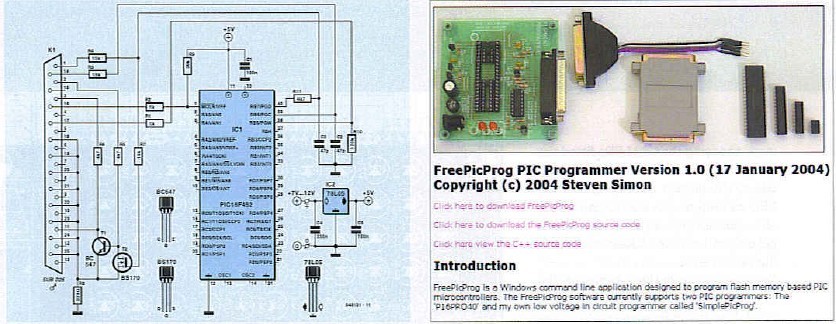

Project Solutions
FreePICProg: cheap'n easy PIC programming
Published:2011/8/5 1:53:00 Author:Li xiao na From:SeekIC
By David Daamen 
The PocketPong game found elsewhere in this issue was designed around a PIC18F452 for which, we have to admit, no suitable programmer was ever published in this magazine. Sure, investing in a commercially produced programmer is an option, but making one yourself is cheaper and much more fun, too!
We reckon that’s what Steven Simon must have thought when he needed a programmer for one of the newer PIC micros. On his website, Steven describes the software he produced for the purpose — both the executable and the source code files may be downloaded free of charge. The program can work with various hardware variants which are also described on the site. The circuit shown in Figure 1 is a related item, albeit a very rudimentary one. No LEDs or other frills — just connect & program!
Construction and operation
The circuit consists mainly of passive parts, the majority of them serving to shape and tidy up various switching signals. Of the active parts, the transistors ensure that the edge steepness of the signal found at the BUSY line (pin 11) is improved. That leaves us with voltage regulator IC1, which we take it is so familiar as to defy further description. The circuit should be easy to build on a small piece of Veroboard. For K1 it is wise to use an angled connector and solder it directly on to the board. The programmer may be plugged directly into the printer port on the PC.
The power supply is uncritical and may be realized using a simple mains adaptor with an output voltage of 7-12 VDC.
Software
The little program called ’fpp.exe’ allows a HEX file to be burned into the PIC micro. The software is compatible with all versions of Windows. However, because the printer port is accessed, Windows NT, 2000 and XP do require an extra driver to be installed — in this case, ’DLPortIO’ from Scientific Software Tools. Incidentally, only LPT1 (0x378h) is supported.
The hardware may be tested by typing this command line:
fpp Ivp —t
where the ’Ivp’ option specifies the programmer type. You may also choose ’lvp_fast’ which speeds up the programming sequence. It may not work in all cases, though, so first give it a try.
Once the hardware has been recognized, the PIC may be installed with the programmer supply switched off. The actual programming operation is launched with
fpp Ivp <PIC type> -p <HEX file>
There are also options for reading a PIC device ID, blank checking, erasing, etc. Type fpp’ only for an overview of all available parameters.
PICs supported
FPP V1.00 supports the following PIC types:
-12F629
-16F876, 16F877, 16F628 (-A suffix versions are not supported!)
-18F252, 18F452
Although the 12F675 is in principle also supported by the software, the hardware shown here is unsuitable for this particular PIC device. For more information, have a look at the web pages covering FPP.
Reprinted Url Of This Article: http://www.seekic.com/blog/project_solutions/2011/08/05/FreePICProg__cheap_'n_easy_PIC_programming.html
Print this Page | Comments | Reading(1158)
Article Categories
New published articles
· Imagination works with TSMC to develop FinFET process
Author:Ecco Reading(33516)
· XMOS pushes event-driven MCUs with lower price
Author:Ecco Reading(3534)
· Intel brings upgraded 32-nm SoC for smartphones
Author:Ecco Reading(3250)
· Micron pushes TLC 128-Gbit NAND flash
Author:Ecco Reading(3816)
· Intel will stop supplying desktop motherboards
Author:Ecco Reading(5341)
· Processor market was expected to regain strength in 2013
Author:Ecco Reading(3318)
· It was reported that TSMC sales fall steeply
Author:Ecco Reading(3474)
· Cisco, NXP work with auto wireless startup
Author:Ecco Reading(3620)
· Micron was impacted by manufacturing glitch
Author:Ecco Reading(4017)
· China can make 22-nm transistor by themselves
Author:Ecco Reading(3819)
· Chip market rebound is coming, according to survey
Author:Ecco Reading(3760)
· Sony, Toshiba will spend more on chips, iSuppli reports
Author:Ecco Reading(3790)
· Qualcomm becomes the 13th company to join NFC Forum board
Author:Ecco Reading(6103)
· TSMC increases building work for FinFET fab
Author:Ecco Reading(3778)
· TI plans to cut 1,700 jobs in OMAP shift
Author:Ecco Reading(4587)